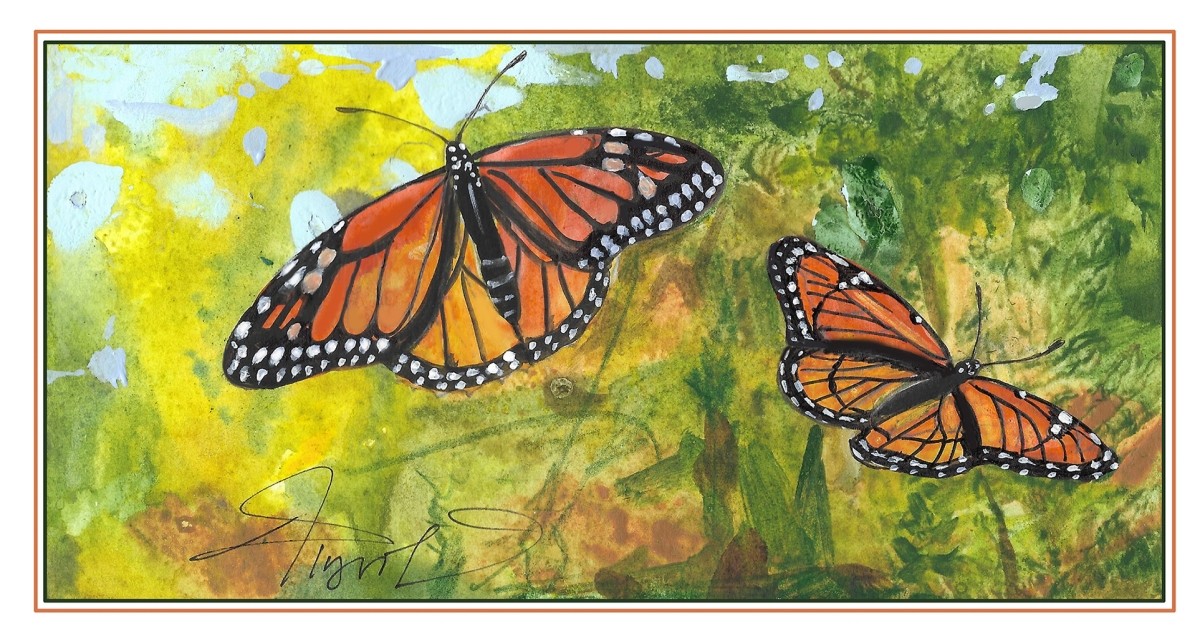
On a warm summer morning, you’re sitting in your yard enjoying a slow moment, when a flash of color catches your eye. Bright orange and black wings dance through the air before alighting on a purple coneflower. There’s a good chance your first thought is “monarch butterfly.” After looking at the butterfly more closely, however, you realize it’s not quite right for a monarch. It’s a bit too small, and there’s a black line bisecting the black veins on both hind wings. This is no monarch: this is a viceroy butterfly.
When I first learned about the viceroy, it was presented as a (literal) textbook example of Batesian mimicry. Batesian mimicry is when a harmless species copies the appearance or behavior – or both – of another species that is distasteful or dangerous to predators. The story goes: monarch butterflies are noxious to potential predators because of the cardenolide toxins lacing their body, courtesy of the milkweed plants the larvae fed on. Viceroy butterflies have no such defenses, so they act as a copy-cat, disguising themselves as monarchs.
This often-repeated tale of the viceroy and monarch, made famous in Intro Ecology textbooks, is incorrect. Research conducted in the 1990s indicated that the viceroy is itself distasteful to predators, perhaps even more so than the monarch. The viceroy caterpillar feeds on the leaves of willows and members of the aspen family, and the leaves of these plants contain salicin, a precursor to salicylic acid which is the active ingredient in aspirin. If you’ve ever mistakenly chewed on an aspirin, you know it is a very bitter pill to swallow. The viceroy caterpillar sequesters the salicylic acid into its tissue, thereby rendering the caterpillar (and butterfly) unappetizing. As a result of this finding, the viceroy and monarch now are considered to be Müllerian mimics: two species that have evolved to look like each other to reinforce the message of unpalatability to predators.
This two-way mimicry is specific to the adult phase of the butterflies’ life cycles; larvae (the caterpillars) and pupae (chrysalises) are quite distinct from each other. The monarch butterfly is boldly colored both as an adult and a caterpillar, using a type of signaling known as aposematism, in which conspicuous colors and patterns warn possible predators that the signaler is toxic. In contrast, the viceroy butterfly employs a more subtle strategy prior to metamorphosis: it mimics plant galls and bird poop.
The eggs, which are deposited on host plants such as willows (favored), poplars, cottonwoods, or aspens, resemble small galls, while the caterpillar and chrysalis stages look a lot like bird droppings. Not many animals have an interest in consuming bird droppings, so this tactic should help reduce rates of predation by visually oriented hunters such as birds. The question is: if both species of butterfly consume and sequester noxious chemicals, why does the viceroy caterpillar adopt a strategy of cryptic mimicry while the monarch caterpillar proclaims its presence via aposematic coloration? The answer may come down to host plant specificity. Viceroys prefer to lay their eggs on willows, but can use a variety of other host plants, some of which contain salicin and some that don’t, whereas the monarch uses only species of milkweed (Asclepias spp.) as host plants, all of which contain cardenolides (although in differing concentrations). The cryptic mimicry of the viceroy may also protect individual caterpillars from predators who might cause lethal damage to the larva before realizing it is distasteful.
While the eastern and central North American populations of monarchs are famous for their migratory journey to Mexico, the viceroy is non-migratory and instead overwinters as a caterpillar, rolled up tight in a leaf. The caterpillar emerges in the spring and commences foraging on the leaves and catkins of the host plant. Once the caterpillar is ready to metamorphose, it crafts the scatological-themed cocoon and spends the next few weeks transforming into a butterfly. When the butterfly emerges from the silken chrysalis, it unfurls its wet wings, spreads them open to dry, and then launches itself into the air – bright orange and black wings a beacon of beauty and bitter taste.


Discussion *